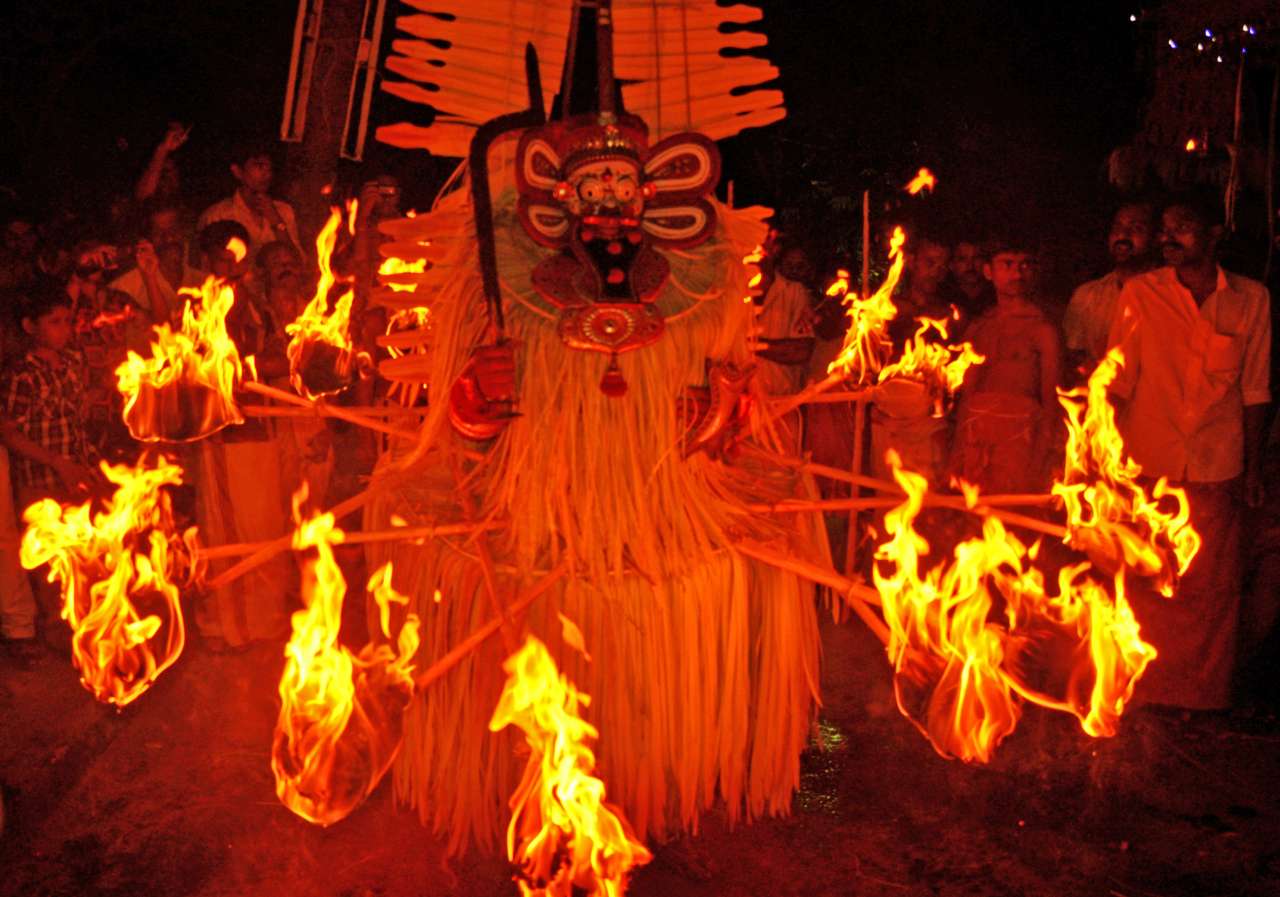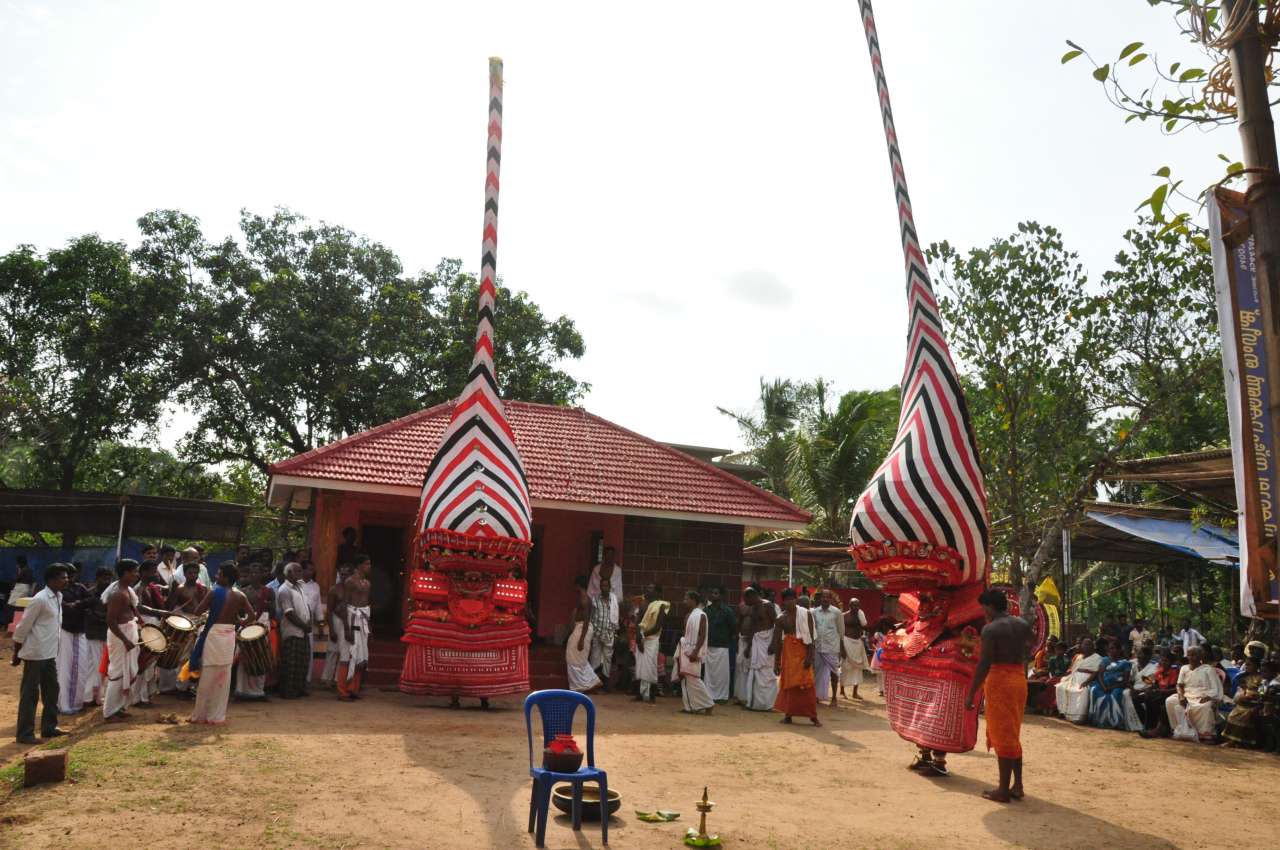Theyyam, a traditional ritual which was an integral part of community life in the North Malabar region of Kerala had lost its patronage in the wave of the social reform movement of the late 19th century. This folk ritual has witnessed a resurgence in recent years with the mushrooming of cult-centres and active community participation. Folklorists and sociologists point to various cultural implications behind this ‘new-found enthusiasm’ in ancient rituals.
According to folklorists, the cult of Theyyam evolved from the fertility rites of primitive agricultural societies. It is associated with the practice of worship of the mother-goddess, goddess of diseases, village-goddess, spirits, ancestors, local heroes, animals and trees. The roots of this folk ritual which combines dance, music and ancient rituals can be traced back to the Chalcolithic age. The myths behind Theyyam deities involve local heroes and incidents, thereby making it a kind of historical documentation of society.

Performance of 'Ghantakarnan' Teyyam at a sacred grove at Peravoor in Kannur district. Pic: A T Mohanraj
The period from December to May marks ‘Theyyam season’ when festivals at various cult-centres including ‘Teyyakkavus’ (sacred groves), houses and farmlands occur. It is believed that as songs on the myth of a particular deity are enacted, the performer transforms into the deity he represents.
In the past few years, Theyyam artists in the region have found themselves busy, thanks to the increased number of cult-centres. Many old sacred groves are being renovated while the ritual has seen a revival at already existing ones. “In our area, three new sacred groves were renovated recently. Theyyam performances which were discontinued for years have resumed at these places,” says V. Krishnan, 60-year-old Theyyam artist from Pazhassi in Kannur.

•
Kerala's development paradox
•
Winds of change in killing fields
According to art critic A T Mohanraj, the reassertion of local culture is a trend observed around the globe which may be seen as an attempt to counter globalization. The post-cold war political situation and the projection of Islamic fundamentalism as a major threat have resulted in religious revitalization. The invoking of ‘Hindu consciousness’ could be seen as a part of this, where traditional rites and rituals reappear in their modified forms.
The advent of modern science, rational thinking and popularisation of materialist ideology took the sheen off traditional rituals like Theyyam. Many superstitions and traditional rituals which were considered irrational were almost wiped away during this period of enlightenment. Folklorist Vasantha Kumari observes that the continuity of the reform movement was subsequently broken and the sense of the’ failure of materialist ideology’ created an ideological vacuum. This is now being filled by religion and spirituality, as observed in the increasing interest in these fields and Vedic sciences like astrology.
Theyyam is associated with fertility rites and many of its myths are related to curing of diseases, and agricultural productivity. Vasantha Kumari says that the change in the feudal system brought about by land reforms and the shift to nuclear families were some of the reasons for abandonment of many Teyyakkavus. “As life gets more and more fragmented there is an increased tendency to bond with the community. People have a nostalgic yearning to go back to the ‘goodness of the past’, she says. She observes that the ritual earlier dismissed as superstition by many was later elevated to the status of an art form.
Academic interest and various government projects to encourage folk art which began during the 1970s sustained the interest. There was also a change in perspective towards the concept of ‘kavus’ which were earlier thought as unused land to be cleared off, till studies brought to light their ecological importance.
Theyyam which is a ritual of the lower castes is more accommodative and allows modification and insertions unlike the rigid Brahminical system, says T.V. Chandran, author of the book ‘Ritual as Ideology: TextandContext in Theyyam.’ According to him, ‘Onnoru Nalpathu’ or the 39 theyyam deities were stylized by the Mandalam Gurikkal as per the directions of a local ruler Chirakkal Raja. The heroic deities such as Muthappan which were not included under this are celebrated or worshipped more at houses. “The formation of new shrines and deities is not a new trend, but the increased enthusiasm being witnessed now is unprecedented,” he says.
Chandran points out that the attraction towards ‘spectacles’ and festive spirit draws the post-modern generation towards carnivals. Theyyam allows the devotee direct communication with the deity. This proximity and immediacy provides a unique experience to the audience. Cultural programmes like music, dance and drama are organised at cult-centres adding to the aura of the spectacle. More than faith, may be it is the festive spirit that pulls crowds towards the cult-centres, he adds.

Performance of mother-goddesses in front of the sanctum-sanctorum at a sacred grove in Payannur. Pic: A.T. Mohanraj
Vasantha Kumari draws attention to the economic aspects of the issue. There was a time when many shrines could not be maintained due to lack of money. Now, lakhs are being spent on organising annual festivals. Serving free food to devotees has also become a common practice at many places. “Shrines are a source of income as well as centres of power that could influence the community around it. Many temple committees are run by the Rashtriya Swayam Sevak Sangh-Bharatiya Janata Party (RSS-BJP) combine, who use them to spread their political ideology,” she adds.
It is ironical however, that Theyyam -- a folk art which expressed the injustice and oppression faced by the lower caste people -- is now being appropriated into the Brahminical system. It was seen as a unique ritual where the higher caste people bowed before people belonging to lower castes while the latter performed the role of deities. This subverted the caste hierarchy even as it existed within the limitations of the caste system. Many of its myths spoke against the cruelty and exploitation suffered by the downtrodden.
As folklorist K.N.Panikker points out, ‘Brahminisation’ or ‘Sanskritisation’ which is the political agenda of religious fascism has interpolated itself into the myths and rites associated with Theyyam. The messages rooted in the social and political consciousness of the lower caste people who suffered the evils of the caste system are all getting submerged beneath the religious fervor of Hinduism, observes Chandran. According to him, even those who perform the rituals fail to understand how the nuances in the modification of myths establish the superiority of Brahmin gods. The higher mythology is projected above lower mythologies and the whole cult is being appropriated into the Tantric system. Conversion of ‘kavus’ to temples, daily offering of prayers and increasing importance of Brahmin priests in worship centres of lower castes could be seen as part of this.
According to Ashoka Mundon, Head of the Department of History, University of Calicut, rituals like Theyyam assume prominence in the postmodern context of decentralization that accommodates marginalized cultural elements. But, they reappear in modified forms and their function in society would be different. “Caste still remains a primary identity and caste-based groups and organizations are gaining momentum now. This reinforcement of caste identities might not necessarily result in hierarchisation as in the feudal era; in the changed context this might produce different results which need to be observed and studied,” he says.
The evolution of local cultural elements and their socio-cultural implication gain importance at a time when cultural resistance to globalization across the globe is being observed carefully. Such developments might have broader significance in discussions on post-postmodernism and metamodernism.























